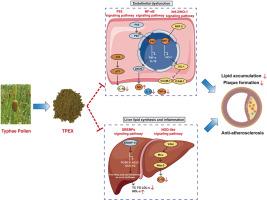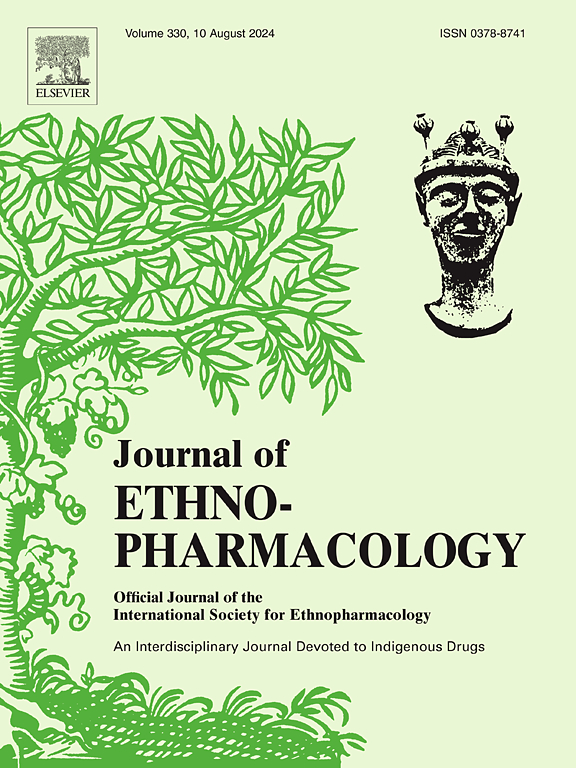蒲孢粉通过增强血管内皮功能和脂质代谢来减轻动脉粥样硬化。
IF 5.4
2区 医学
Q1 CHEMISTRY, MEDICINAL
引用次数: 0
摘要
民族药理学相关性:动脉粥样硬化是一种病理状况,其特征是内皮层内富含脂质病变的积累,它仍然是全球发病率和死亡率的重要因素。伤寒花粉已被广泛用于治疗瘀血。然而,TP在动脉粥样硬化中的潜在保护作用和潜在机制尚不清楚。目的:探讨蒲黄花粉提取物(TPEX)对动脉粥样硬化的保护作用及其机制。材料和方法:采用高脂饮食(high-fat diet, HFD)建立ApoE-/-小鼠动脉粥样硬化模型,并在体内按规定剂量和间隔连续口服TPEX。为了探索TPEX的潜在机制,我们采用了综合网络药理学和转录组分析。采用western blot、免疫荧光、核/细胞质蛋白分离技术,在体外建立棕榈酸和H2O2诱导原代肝细胞脂质积累和内皮细胞功能障碍模型,探讨TPEX作用的可能机制。结果:TPEX改善了hfd诱导的ApoE-/-小鼠主动脉脂质沉积和动脉损伤,减轻了高脂血症,减轻了肝损伤。机制上,TPEX通过p53/p21信号通路减轻内皮细胞衰老,通过抑制p65转位进入细胞核抑制炎症,通过阻止NRF2核易位和调节NRF2/HO-1通路减轻氧化应激。此外,TPEX通过肝脏NOD信号通路和SREBPs信号通路减少炎症和调节脂质代谢。结论:TPEX通过调节内皮功能障碍、肝脂质代谢和炎症过程减轻动脉粥样硬化。这些发现为TPEX在动脉粥样硬化中的保护作用提供了新的见解,特别是在内皮功能障碍和肝脂质代谢方面。本文章由计算机程序翻译,如有差异,请以英文原文为准。

Typhae pollen attenuates atherosclerosis by enhancing vascular endothelium function and lipid metabolism
Ethnopharmacological relevance
Atherosclerosis is a pathological condition characterized by the accumulation of lipid-rich lesions within the endothelial layer, and it remains a significant contributor to global morbidity and mortality. Typhae Pollen (TP) has been extensively used in the treatment of blood stasis. However, the potential protective effects and underlying mechanisms of TP in atherosclerosis remain poorly understood.
Aim of the study
To explore the protective effects and mechanisms of Typhae Pollen extract (TPEX) on atherosclerosis.
Materials and methods
We established atherosclerosis models in ApoE−/− mice using high-fat diet (HFD), with continuous oral administration of TPEX at specified doses and intervals in vivo. To explore the underlying mechanisms of TPEX, we employed integrated network pharmacology and transcriptome analysis. In vitro, palmitic acid and H2O2 induced primary hepatic cells lipid accumulation and endothelial cells dysfunction model were employed to investigate the potential mechanisms of TPEX using Western blot, immunofluorescence, nuclear/cytoplasmic proteins isolation techniques.
Results
TPEX improved aortic lipid deposition and arterial injury, alleviated hyperlipidemia, and reduced liver damage in HFD-induced ApoE−/− mice. Mechanistically, TPEX mitigated endothelial cell senescence through the p53/p21 signaling pathway, suppressed inflammation by inhibiting the translocation of p65 into the nucleus, and alleviated oxidative stress by preventing the nuclear translocation of NRF2 and modulating the NRF2/HO-1 pathway. Furthermore, TPEX reduced inflammation and regulated lipid metabolism via the NOD signaling pathway and the SREBPs signaling pathway in the liver.
Conclusion
TPEX alleviates atherosclerosis by regulating endothelial dysfunction, hepatic lipid metabolism, and inflammatory processes. These findings provide new insights into the protective role of TPEX in atherosclerosis, especially regarding endothelial dysfunction and hepatic lipid metabolism.
求助全文
通过发布文献求助,成功后即可免费获取论文全文。
去求助
来源期刊

Journal of ethnopharmacology
医学-全科医学与补充医学
CiteScore
10.30
自引率
5.60%
发文量
967
审稿时长
77 days
期刊介绍:
The Journal of Ethnopharmacology is dedicated to the exchange of information and understandings about people''s use of plants, fungi, animals, microorganisms and minerals and their biological and pharmacological effects based on the principles established through international conventions. Early people confronted with illness and disease, discovered a wealth of useful therapeutic agents in the plant and animal kingdoms. The empirical knowledge of these medicinal substances and their toxic potential was passed on by oral tradition and sometimes recorded in herbals and other texts on materia medica. Many valuable drugs of today (e.g., atropine, ephedrine, tubocurarine, digoxin, reserpine) came into use through the study of indigenous remedies. Chemists continue to use plant-derived drugs (e.g., morphine, taxol, physostigmine, quinidine, emetine) as prototypes in their attempts to develop more effective and less toxic medicinals.
 求助内容:
求助内容: 应助结果提醒方式:
应助结果提醒方式:


